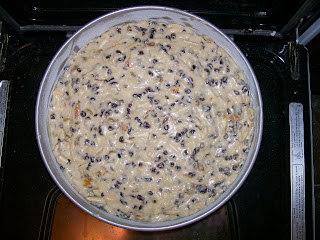Happy Twelfth Day of Christmas!
Twelfth Day/Night, aka Epiphany, is the last day of Christmas--the final night* of a nearly-two-week party. An important part of the festivities is the crowning of the Twelfth Night King. Though a later Victorian invention assigned the role of King and/or Queen by
drawing cards (with all party-goers assigned a
different character to assume for the evening), the traditional method of choosing the monarch is the
Twelfth Night cake. Popular amusements include
card Games and play-acting; aside from the singing/drinking/doing silly stunts for luck.
*Not counting Plough Monday
There's many mentions of "Twelfth Night Cake" in the literature of the 1800s and before. By the 1860s, the cakes are elaborately decorated with marzipan and sugar sculptures, and the cake's defining feature--selecting a king and/or queen--has been outsourced to printed cards. Earlier cakes, however, had a bean, coin, or ring baked into the cake. The person who found this item became king/queen for the day. Alternatively, both a pea and a bean may be hidden in the cake: the bean determining the king, and the pea the queen. For recipes, however, there's just a rote list of
"flour, honey, ginger, and pepper" as the traditional ingredients.
I have managed to track down two recipes from before 1900 (and Quinn found a third). [Edited: I may have found a fourth, from 1860,
here.] One is from an 1806 cook book, shown at
austenonly.com, which also has very pretty pictures of the cake made up, complete with small sugar crowns to honor the day's king and queen. The other recipe is included in a story from
1888, and appears to be the more manageable of the pair:
ENGLISH TWELFTH NIGHT CAKE.-- One pound of butter washed first in water, then in rose-water; one pound of sugar, one pound of candied citron, orange and lemon peels in equal proportions; three pounds of currants, one pound of sultana raisins, three quarters of a pound of almonds, blanched and chopped a little the grated rind of two oranges; a gill of sherry, one of brandy, yolks of twelve and whites of six eggs, one pound of flour, very dry and warm; a small teaspoonful each of cinnamon, grated nutmegs, and cloves.
The butter and sugar to be beaten with the hand until it will stand; add yolks of eggs and beat thoroughly; then the flavoring the whites and flour, the last added gradually. The fruit must be well cleaned and dried the peels shredded, and then all made quite warm and floured. They must be stirred into the batter last. Line a round pan or hoop with the three thicknesses of buttered paper at bottom, two round the sides and pour the batter into it. It will, of course, be very stiff. This cake will be quite large if baked in one, and should have five hours' baking in regular moderate heat. The oven should be quite cool at first and never get very hot; for the first two hours a thick card cover may be placed on it. The great object is to give long baking without burning. The crust should not form for at least two hours. This is known in England as Twelfth Cake and is excellent.
"The Twelfth Cake was almost always accompanied by the Wassail Bowl, a composition of spiced wine or ale, or mead, or metheglin, into which was thrown roasted apples, sugar, etc...the custom has prevailed in Britain of using these words whilst drinking; the person who drank to another saying was-heil and he who received the cup answering drinc-heil."
--Shakspear and His Times, 1817
 |
| Definition of "wassail", 1787. Recall the long "s" looks like an "f". |
References to Wassail most commonly name spiced wine (
white) with roasted apples, though the recipes I've found are all for spiced ale. In apple country, it's traditional to drink
cider and "wassail" all the orchard trees. Not being an ale-fan, I'll be serving wine and mead wassail with the cake. But for any interested readers, here's one of the more straight-forward spiced ale receipts:
Wassail Bowl--Heat in a saucepan a pint of strong ale, Burton Scotch or Canadian malt ale would be best, with half a pound of sugar, a grated nutmeg, and half an ounce grated ginger--the white ginger root, don't use the bought powdered ginger. When it has just boiled up, add a quart more ale, half a pint of sherry, and two lumps of sugar that have been rubbed over the peel of a lemon. Make the whole very hot, without boiling. Have the bowl ready and hot, with half a dozen roasted apples [other sources make it clear that crab apples are traditionally used--EK] cored but not peeled in it; pour in the liquid, add a few thin slices of lemon, and the wassail is ready
--Good Housekeeping, 1886 (recipe said to be from "the reign Queen Anne", 1702-1714)








No comments:
Post a Comment
Thanks for commenting!